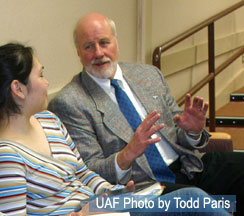#1) Marshall Lind: Educator and former chancellor
 Click here to listen to the audio. Story length: 4:05 minutes. File size: 2:38 MB.
Click here to listen to the audio. Story length: 4:05 minutes. File size: 2:38 MB.  Narrator: Welcome to "History at Risk: Linking Alaskans to their past". The history of Alaska's rural education is marked by many teachers who cared deeply for the children, their families and their subsistence based life. These bush educators understood the trade offs for high school students forced to leave their communities. In 1972, Alaska legal services filed a lawsuit against the state claiming rural native students were discriminated against because they had to leave their homes to attend high school. One of the key players in the legal process that led to a settlement was marshall lind.
Narrator: Welcome to "History at Risk: Linking Alaskans to their past". The history of Alaska's rural education is marked by many teachers who cared deeply for the children, their families and their subsistence based life. These bush educators understood the trade offs for high school students forced to leave their communities. In 1972, Alaska legal services filed a lawsuit against the state claiming rural native students were discriminated against because they had to leave their homes to attend high school. One of the key players in the legal process that led to a settlement was marshall lind.Narrator: As the controversial trial known as the “Molly Hootch case” heated up, Lind found himself as a defendant. But based on his history of trying to keep high school students in state, he proved to be sympathetic to the plaintiffs. Lind’s experience and his ability to work with people were key factors in bringing about change.
Lind: “When the Molly Hootch case was started, the Plaintiffs were students we had in school when we were teaching out there not so many years before that. In fact, Molly Hootch was a student of my wife’s in Emmonok. The State Board of Education at the time wanted to make some major changes in rural education. And then when the Hootch Case came along, it was not only directed to keep kids in the state, but also to try to provide programs where they actually live in their various villages and communities.”
Narrator: The 1976 landmark out-of-court settlement provided for rural schooling and set in motion a new chapter in community involvement in education. But it wasn’t easy: in the years to follow, Lind worked with the state legislature to secure a statewide bond to build schools in rural Alaska.
Lind: “It was during a time when the state was coming into money with the pipeline and the oil beginning to flow, and we could see that the state would have some revenue. And there was a good attitude about sharing that revenue throughout the state to the rural areas as well as the urban. So all the pieces kind of came together and we arrived at a consent decree, which said that we would build schools where communities wanted a local school. We did all of this between 1972 and 1976 when all of the implementation of the rural secondary schools took place.”
Narrator: The decision to build schools in bush communities instituted major change, and everyone had a different idea about how secondary education could best be provided. Lind’s opinions were backed by a lot of concerned parents.
Lind: “We did the best that we could with the knowledge that we had at the time. The strength of the whole effort was tied to the fact that the local communities got involved. And then we put provisions in place through the regulatory process that allowed for the communities to be involved in the curriculum determination, the assessment of the learning process, and there were a lot of good pieces put into play that involved the local communities.”
Narrator: Today, Alaska rural schools continue to provide a solid foundation for communities that value education. Lind’s bush experience and his cultural sensivity, helped transform the states educational landscape at a critical time.
Narrator: Funding was provided by the University of Alaska President's Special Projects Fund. From the University of Alaska Fairbanks Oral History Program, this is Bill Schneider.
Photo credit: UAF Photo of Marshall Lind by Todd Paris.